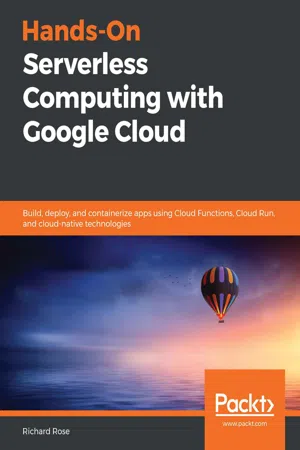
Hands-On Serverless Computing with Google Cloud
Build, deploy, and containerize apps using Cloud Functions, Cloud Run, and cloud-native technologies
- 320 pages
- English
- ePUB (mobile friendly)
- Available on iOS & Android
Hands-On Serverless Computing with Google Cloud
Build, deploy, and containerize apps using Cloud Functions, Cloud Run, and cloud-native technologies
About This Book
Effectively deploy fully managed workloads using Google Cloud's serverless services
Key Features
- Use real-world use cases to understand the core functionalities of Functions as a Service
- Explore the potential of Cloud Run, Knative, Cloud Build, Google Kubernetes Engine, and Cloud Storage
- Get to grips with architectural decisions, seamless deployments, containerization, and serverless solutions
Book Description
Google Cloud's serverless platform allows organizations to scale fully managed solutions without worrying about the underlying infrastructure. With this book, you will learn how to design, develop, and deploy full stack serverless apps on Google Cloud.
The book starts with a quick overview of the Google Cloud console, its features, user interface (UI), and capabilities. After getting to grips with the Google Cloud interface and its features, you will explore the core aspects of serverless products such as Cloud Run, Cloud Functions and App Engine. You will also learn essential features such as version control, containerization, and identity and access management with the help of real-world use cases. Later, you will understand how to incorporate continuous integration and continuous deployment (CI/CD) techniques for serverless applications. Toward the concluding chapters, you will get to grips with how key technologies such as Knative enable Cloud Run to be hosted on multiple platforms including Kubernetes and VMware.
By the end of this book, you will have become proficient in confidently developing, managing, and deploying containerized applications on Google Cloud.
What you will learn
- Explore the various options for deploying serverless workloads on Google Cloud
- Determine the appropriate serverless product for your application use case
- Integrate multiple lightweight functions to build scalable and resilient services
- Increase productivity through build process automation
- Understand how to secure serverless workloads using service accounts
- Build a scalable architecture with Google Cloud Functions and Cloud Run
Who this book is for
If you are a cloud administrator, architect, or developer who wants to build scalable systems and deploy serverless workloads on Google Cloud, then this book is for you. To get the most out of this book, a basic understanding of the serverless ecosystem and cloud computing will be beneficial.
Frequently asked questions
Information
Section 1: App Engine
- Chapter 1, Introducing App Engine
- Chapter 2, Developing with App Engine
Introducing App Engine
- Introducing GAE
- Understanding the GAE framework
- Defining App Engine components
- Understanding GAE's features
Introducing GAE
- Why go serverless with App Engine?
- What is the underlying App Engine framework?
- How does App Engine handle auto-scaling?
- Who is the target audience?
Why go serverless with App Engine?

- App Engine Standard
- App Engine Flex

Table of contents
- Title Page
- Copyright and Credits
- About Packt
- Contributors
- Preface
- Section 1: App Engine
- Introducing App Engine
- Developing with App Engine
- Section 2: Google Cloud Functions
- Introducing Lightweight Functions
- Developing Cloud Functions
- Exploring Functions as a Service
- Cloud Functions Labs
- Section 3: Google Cloud Run
- Introducing Cloud Run
- Developing with Cloud Run
- Developing with Cloud Run for Anthos
- Cloud Run Labs
- Section 4: Building a Serverless Workload
- Building a PDF Conversion Service
- Consuming Third-Party Data via a REST API
- Assessments
- Other Books You May Enjoy